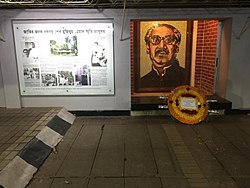
Sheikh Mujibur Rahman, popularly known by the honorific prefix Bangabandhu, was a Bangladeshi politician, revolutionary, statesman, activist and diarist. As a politician, Mujib had held continuous positions either as Bangladesh's president or as its prime minister from April 1971 until his assassination in August 1975. Mujib successfully led the Bangladeshi independence movement and restored the Bengali sovereignty after over two centuries following the Battle of Plassey in 1757, for which he is honoured as the 'Father of the Nation' in Bangladesh. In 2011, the fifteenth constitutional amendment in Bangladesh referred to Sheikh Mujib as the Father of the Nation who declared independence; these references were enshrined in the fifth, sixth, and seventh schedules of the constitution. His Bengali nationalist ideology, socio-political theories, and political doctrines are sometimes called Mujibism.
Khondaker Mostaq Ahmad was a Bangladeshi politician. He was the fourth president of Bangladesh from 15 August to 6 November 1975, after the assassination of Sheikh Mujibur Rahman. He was involved in the assassination of Bangabandhu Sheikh Mujibur Rahman on 15 August 1975. He took on the role of president immediately after the assassination, praised the assassins as "sons of the sun" and put cabinet ministers loyal to Sheikh Mujibur Rahman in jail.

The first president of Bangladesh, Sheikh Mujibur Rahman, and most of his family were killed during the early hours of 15 August 1975 by a group of Bangladesh Army personnel who invaded his Dhanmondi 32 residence as part of a coup d'état. Minister of Commerce, Khondaker Mostaq Ahmad, immediately took control of the government and proclaimed himself president. The assassination marked the first direct military intervention in Bangladesh's civilian administration-centric politics. 15 August is National Mourning Day, an official national holiday in Bangladesh.
Sheikh Fazlul Haque Moni was a Bangladeshi politician. He was one of the nephews of Bangabandhu Sheikh Mujibur Rahman the founding father of Bangladesh. He was the founder of Mujib Bahini Bangladesh Liberation Force-BLF one of the major guerrilla forces of the Bangladesh Liberation War and also the founder of Bangladesh Awami Jubo League, the youth wing of Bangladesh Awami League.

The independence of Bangladesh was declared on 26 March 1971, at the onset of the Bangladesh Liberation War by Bangabandhu Sheikh Mujibur Rahman; the following day the declaration was broadcast by Major Ziaur Rahman from Swadhin Bangla Betar Kendra radio station in kalurghat, Chattogram. On 10 April, the Provisional Government of Bangladesh issued a proclamation on the basis of the previous declaration and established an interim constitution for the independence movement.
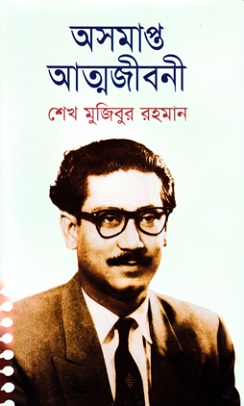
The Unfinished Memoirs is the autobiography by Sheikh Mujibur Rahman, Father of the nation of Bangladesh.

Begum Sheikh Fazilatunnesa Mujib, commonly known as Begum Mujib; and also known by her nickname Renu, was the wife of Sheikh Mujibur Rahman, the founder and the first President of Bangladesh. She is the mother of Sheikh Hasina, who is now Prime Minister of Bangladesh. She was assassinated with her husband, brother-in-law, 3 sons and 2 daughters-in-law.

Sheikh Rehana Siddiq is a Bangladesh Awami League politician. She is the younger sister of the current Prime Minister Sheikh Hasina and the daughter of the first President of Bangladesh Sheikh Mujibur Rahman. She is also the mother of Tulip Siddiq, a British Labour Party politician and elected Member of Parliament (MP) for the Hampstead and Kilburn constituency.
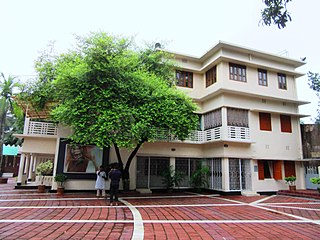
The Sheikh family of Tungipara is one of the two most prominent Bangladeshi political families, other being the Zia family. The family primarily consists of Sheikh Mujibur Rahman, Sheikh Hasina, Sheikh Rehana and their relatives. Their political involvement has traditionally revolved around the Bangladesh Awami League.

Sheikh Russel was the youngest child of Sheikh Mujibur Rahman, the founding father and first President of Bangladesh. Russel and most of his direct family were killed in their home during the 1975 military coup.

The 15 August 1975 Bangladesh coup d'état was a military coup launched by mid ranking army officers in Bangladesh on 15 August 1975. The officers were part of a conspiracy to assassinate Sheikh Mujibur Rahman, the founding father of Bangladesh, who led the independence struggle during the Bangladesh Liberation War and later served as the first and fourth president and later in between his two presidential terms served as the second prime minister of Bangladesh from April 1971 until his assassination in August 1975. Sheikh Mujibur Rahman and most of his family members were killed during the coup, with the exception of his two daughters Sheikh Hasina and Sheikh Rehana.
Sheikh Sayera Khatun was the matriarch of Sheikh-Wazed political family and mother of Sheikh Mujibur Rahman, the founding president of Bangladesh. She was the grandmother of the Prime Minister of Bangladesh, Sheikh Hasina.
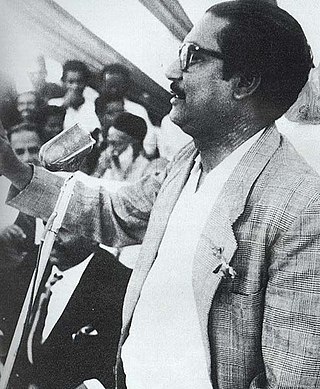
Mujibism refers to the political view held and propagated by Sheikh Mujibur Rahman, the architect of the liberation movement of Bangladesh. Mujibism consists of four fundamental policies: nationalism, socialism, democracy, and secularism. On 7 June 1972, he said that before the country's liberation, the slogans were the six points, now the slogans were the four pillars. When the Constitution of Bangladesh was adopted in 1972, the four pillars become the four fundamental state policies of Bangladesh.
Bangabandhu Memorial Trust is a trust in Bangladesh that was created to remember Sheikh Mujibur Rahman, the founding father of Bangladesh. Prime Minister Sheikh Hasina is the chair of the trust.
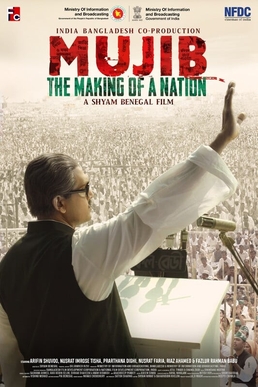
Mujib: The Making of a Nation is a 2023 epic biographical film based on the life of Sheikh Mujibur Rahman, the founding father and first president of Bangladesh who is popularly known as Bangabandhu. A co-production between Bangladesh and India, the film was directed by Shyam Benegal and stars Arifin Shuvoo in the titular role.
Bangabandhu Sheikh Mujib Road is a street situated in Lutyens' Delhi at the centre of New Delhi, capital of India. The road was formerly named Park Street. The name was changed by New Delhi Municipal Council as a "friendly gesture" towards Bangladesh. The road is named after Bangabandhu Sheikh Mujibur Rahman, Founding Father of Bangladesh. The newly renamed road was opened by Prime Minister Sheikh Hasina and Prime Minister Narendra Modi on 8 April 2017.

"Jodi Raat Pohale Shona Jeto" is a song from the 1991 Bangladeshi music album named Jonotar Nouka. The lyricist of this modern music was Hasan Motiur Rahman. Moloy Kumar Ganguly composed sang originally this song to the tune with music arrangement of Almas Ali. The song is considered to be the most popular song about Sheikh Mujibur Rahman. The song was released under label of Chenasur along with other songs from the audio album.

The Mausoleum of Bangabandhu Sheikh Mujibur Rahman is the mausoleum of Sheikh Mujibur Rahman, the founder and the first president of the People's Republic of Bangladesh. It is located in Tungipara of Gopalganj district, the birthplace of Mujib, and was designed by architects Ehsan Khan, Ishtiaque Jahir and Iqbal Habib.

Khoka Theke Bangabandhu Jatir Pita is a 2021 Bangladeshi full-length animated feature film, based on the life of Sheikh Mujibur Rahman, the founding father and first President of Bangladesh. The film was produced by AGAMiLabs and directed by Dr. Md. Hanif Seddiqui. The film is based on national textbooks including Sheikh Mujibur Rahman's The Unfinished Memoirs, The Prison Diaries and his daughter Sheikh Hasina's book Sheikh Mujib Amar Pita. The film shows Sheikh Mujibur Rahman's childhood, his relationship with the land and people of Bengal, his mind and interaction with the world around him.
